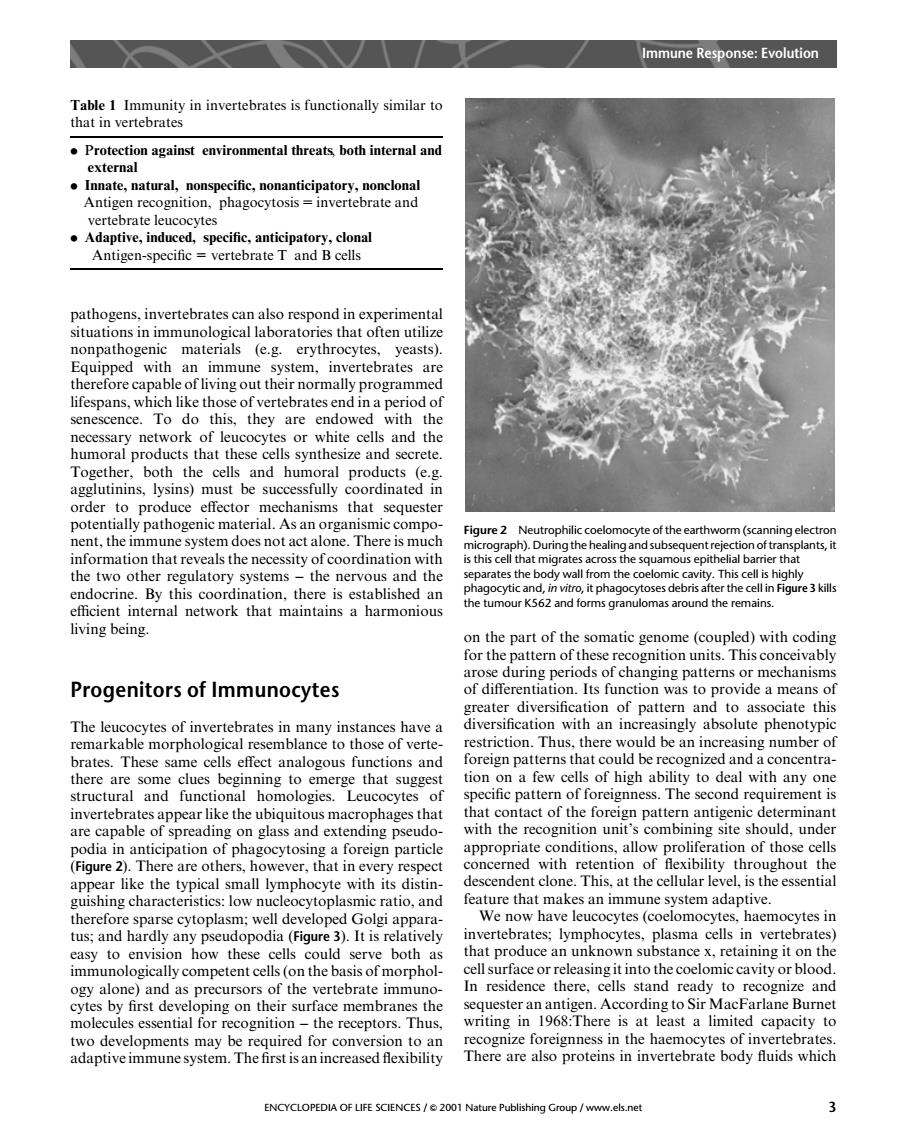正在加载图片...

Immune Response:Evolution Table 1 Immunity in invertebrates is functionally similar to that in vertebrates Innate,natural,nonspecific,nonanticipatory,nonclonal Antigen recognition,phagocytosis=invertebrate and ecific.anticipatory.clona vertebrate t and b cells pathogens.invertebrates can also respond in experimental situations in immunological laboratories that often utilize nonpathogenic materials (e.g.erythrocytes,yeasts) Equipped wi abl an em,invertebrates are lifespans.which like those of seescenceTdo this theyr endowed with the sor white cells and the humo synt order to produce effector mechanisms that sequester ocye of the e on thne Du nd su reje tran olants.it Is the eparates the body wall fr n the coelor endocrine.By this coordination,there is established an This cell internal network that maintains a harmonious the tumour K562and around the remains ing led)with codir arose during periods of changing patterns or mechanisms Progenitors of Immunocytes of differ on.Its fun tion was to provide a means o ate us functions and foreign patterns that could be recognized and a concentra- there are some clues beginning to emerge that suggest ionon a few cells of high ability to deal with any one structural and funct onal homologies.Leucocytes invertebr site should.under podiohparie a foreign particle appropriate conditions,allow proliferation of those cells endent c We now have leucocvtes (coelomocytes.haemocvtes in nvertebrates:lymphocytes.plasma cells in vertebrates) easy to envision how these cells could serve both as hat produce an unkno su tance x.retaining it on the immunologically competent cells(on the basis of morphol asing ls the coe ogy alonean as precurso mmun ester an ar tigen.According to Sir MacFarlane Burne writing in 1968:There is at least a limited capacity to two developments may be required for conversion to ar reignne adaptive immune system.The first is an increased flexibility ENCYCLOPEDIA OF LIFE SCIENCES/2001 Nature Publishing Group /www.els.net pathogens, invertebrates can also respond in experimental situations in immunological laboratories that often utilize nonpathogenic materials (e.g. erythrocytes, yeasts). Equipped with an immune system, invertebrates are therefore capable of living out their normally programmed lifespans, which like those of vertebrates end in a period of senescence. To do this, they are endowed with the necessary network of leucocytes or white cells and the humoral products that these cells synthesize and secrete. Together, both the cells and humoral products (e.g. agglutinins, lysins) must be successfully coordinated in order to produce effector mechanisms that sequester potentially pathogenic material. As an organismic component, the immune system does not act alone. There is much information that reveals the necessity of coordination with the two other regulatory systems – the nervous and the endocrine. By this coordination, there is established an efficient internal network that maintains a harmonious living being. Progenitors of Immunocytes The leucocytes of invertebrates in many instances have a remarkable morphological resemblance to those of vertebrates. These same cells effect analogous functions and there are some clues beginning to emerge that suggest structural and functional homologies. Leucocytes of invertebrates appear like the ubiquitous macrophages that are capable of spreading on glass and extending pseudopodia in anticipation of phagocytosing a foreign particle (Figure 2). There are others, however, that in every respect appear like the typical small lymphocyte with its distinguishing characteristics: low nucleocytoplasmic ratio, and therefore sparse cytoplasm; well developed Golgi apparatus; and hardly any pseudopodia (Figure 3). It is relatively easy to envision how these cells could serve both as immunologically competent cells (on the basis of morphology alone) and as precursors of the vertebrate immunocytes by first developing on their surface membranes the molecules essential for recognition – the receptors. Thus, two developments may be required for conversion to an adaptive immune system. The first is an increased flexibility on the part of the somatic genome (coupled) with coding for the pattern of these recognition units. This conceivably arose during periods of changing patterns or mechanisms of differentiation. Its function was to provide a means of greater diversification of pattern and to associate this diversification with an increasingly absolute phenotypic restriction. Thus, there would be an increasing number of foreign patterns that could be recognized and a concentration on a few cells of high ability to deal with any one specific pattern of foreignness. The second requirement is that contact of the foreign pattern antigenic determinant with the recognition unit’s combining site should, under appropriate conditions, allow proliferation of those cells concerned with retention of flexibility throughout the descendent clone. This, at the cellular level, is the essential feature that makes an immune system adaptive. We now have leucocytes (coelomocytes, haemocytes in invertebrates; lymphocytes, plasma cells in vertebrates) that produce an unknown substance x, retaining it on the cell surface or releasing it into the coelomic cavity or blood. In residence there, cells stand ready to recognize and sequester an antigen. According to Sir MacFarlane Burnet writing in 1968:There is at least a limited capacity to recognize foreignness in the haemocytes of invertebrates. There are also proteins in invertebrate body fluids which Table 1 Immunity in invertebrates is functionally similar to that in vertebrates . Protection against environmental threats, both internal and external . Innate, natural, nonspecific, nonanticipatory, nonclonal Antigen recognition, phagocytosis 5 invertebrate and vertebrate leucocytes . Adaptive, induced, specific, anticipatory, clonal Antigen-specific = vertebrate T and B cells Figure 2 Neutrophilic coelomocyte of the earthworm (scanning electron micrograph). During the healing and subsequent rejection of transplants, it is this cell that migrates across the squamous epithelial barrier that separates the body wall from the coelomic cavity. This cell is highly phagocytic and, in vitro, it phagocytoses debris after the cell in Figure 3 kills the tumour K562 and forms granulomas around the remains. Immune Response: Evolution ENCYCLOPEDIA OF LIFE SCIENCES / & 2001 Nature Publishing Group / www.els.net 3